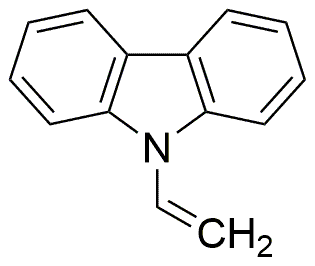9-Vinylcarbazole is widely utilized in research focused on:
- Polymer Chemistry: It serves as a monomer in the synthesis of conductive polymers, enhancing the electrical properties of materials used in electronic devices.
- Photovoltaic Cells: This compound is incorporated into organic solar cells, improving light absorption and energy conversion efficiency, making renewable energy sources more viable.
- Biomedical Applications: Its derivatives are explored for drug delivery systems due to their biocompatibility and ability to form hydrogels, which can encapsulate therapeutic agents.
- Fluorescent Dyes: 9-Vinylcarbazole is used in the production of fluorescent dyes for biological imaging, providing clear visualization in research and diagnostic applications.
- Light Emitting Devices: It plays a key role in the development of organic light-emitting diodes (OLEDs), offering advantages like flexibility and lower energy consumption compared to traditional lighting technologies.
General Information
Properties
Safety and Regulations
Applications
9-Vinylcarbazole is widely utilized in research focused on:
- Polymer Chemistry: It serves as a monomer in the synthesis of conductive polymers, enhancing the electrical properties of materials used in electronic devices.
- Photovoltaic Cells: This compound is incorporated into organic solar cells, improving light absorption and energy conversion efficiency, making renewable energy sources more viable.
- Biomedical Applications: Its derivatives are explored for drug delivery systems due to their biocompatibility and ability to form hydrogels, which can encapsulate therapeutic agents.
- Fluorescent Dyes: 9-Vinylcarbazole is used in the production of fluorescent dyes for biological imaging, providing clear visualization in research and diagnostic applications.
- Light Emitting Devices: It plays a key role in the development of organic light-emitting diodes (OLEDs), offering advantages like flexibility and lower energy consumption compared to traditional lighting technologies.
Documents
Safety Data Sheets (SDS)
The SDS provides comprehensive safety information on handling, storage, and disposal of the product.
Product Specification (PS)
The PS provides a comprehensive breakdown of the product’s properties, including chemical composition, physical state, purity, and storage requirements. It also details acceptable quality ranges and the product's intended applications.
Certificates of Analysis (COA)
Search for Certificates of Analysis (COA) by entering the products Lot Number. Lot and Batch Numbers can be found on a product’s label following the words ‘Lot’ or ‘Batch’.
Numéro de catalogue
Numéro de lot/série
Certificates Of Origin (COO)
This COO confirms the country where the product was manufactured, and also details the materials and components used in it and whether it is derived from natural, synthetic, or other specific sources. This certificate may be required for customs, trade, and regulatory compliance.
Numéro de catalogue
Numéro de lot/série
Safety Data Sheets (SDS)
The SDS provides comprehensive safety information on handling, storage, and disposal of the product.
DownloadProduct Specification (PS)
The PS provides a comprehensive breakdown of the product’s properties, including chemical composition, physical state, purity, and storage requirements. It also details acceptable quality ranges and the product's intended applications.
DownloadCertificates of Analysis (COA)
Search for Certificates of Analysis (COA) by entering the products Lot Number. Lot and Batch Numbers can be found on a product’s label following the words ‘Lot’ or ‘Batch’.
Numéro de catalogue
Numéro de lot/série
Certificates Of Origin (COO)
This COO confirms the country where the product was manufactured, and also details the materials and components used in it and whether it is derived from natural, synthetic, or other specific sources. This certificate may be required for customs, trade, and regulatory compliance.


